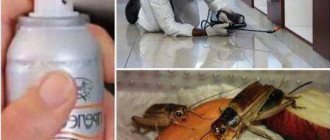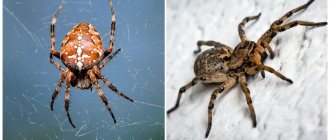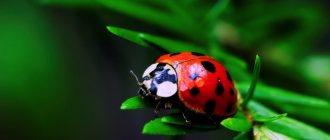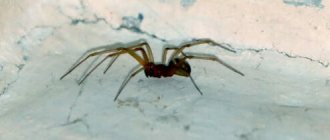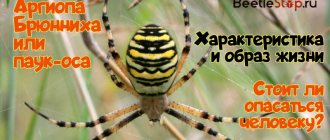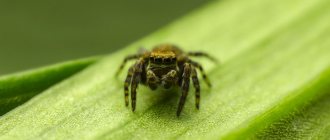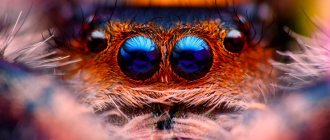Exotic pets are increasingly found in our homes. It is already difficult to surprise anyone with a bright bird or a nimble lizard. Another thing is the tarantula spider. This is such a pet! Many people’s hearts skip a beat at one glance at the “outlandish little animal.” But even such a quiet and unpretentious pet requires courage and some knowledge and skills from the owner. Owners must not only understand the behavior and nutrition of their furry pets, but also understand how the spider molts in order to provide it with the most comfortable conditions for this period.
Why is molting necessary?
The body of a tarantula spider does not have the internal skeleton that is familiar to us. It is covered with an exoskeleton that protects it from external influences. Internal organs and muscle tissue are attached to the external skeleton, which contains chitin and sclerotin. The skeleton itself is an alternation of hard and soft parts with tactile hairs. The outer shell of the exoskeleton is called the cuticle. The presence of a shell makes life easier for the arthropod, but the rigid structure does not allow the arachnid to increase in size. This means that at some point the tarantula must shed its hard shell in order to continue growing. By the way, the shell shed during molting is called exuvium.
Arrangement of the terrarium
The main thing a spider needs is the right terrarium. It must meet several requirements:
- material – plexiglass, ordinary glass or food-grade plastic. An aquarium or a plastic container with holes for ventilation is suitable;
- Dimensions – a large terrarium is not suitable for a spider. Optimally - three times the span of his paws;
- shape - selected based on the type of spider - arboreal spiders need a vertical one, burrowing and ground spiders need a horizontal one.
- the presence of a lid - spiders move well on vertical planes, so they can leave an uncovered terrarium.
Before introducing a tarantula into its home, the terrarium must be prepared. Soil must be placed at the bottom. Experienced owners recommend coconut substrate - it is easy to find in flower shops. An alternative is any other that is clean, has good air permeability and is not very small. The soil needs to be moistened by periodically wetting it with water at room temperature, but avoid overmoistening. When soiled, clean the walls and bottom of the terrarium and change the substrate.
You should not introduce someone to a tarantula. Your pet should live alone. If it is a ground spider, then it will need some kind of shelter. The easiest way is to use coconut shells.
In the wild, tarantulas live in warm countries in warm and dry climates, so the temperature in the terrarium should be maintained at 28-30 degrees. Heaters sold in pet stores can handle this task. You can do without heaters if the room temperature is not lower than 24 degrees. Avoid sudden changes in temperature, which are dangerous for tarantulas.
Tarantulas have poor vision and do not need bright light. Place the terrarium in a dark place so that your pet does not experience stress.
General information about shedding
The molt of a tarantula spider is divided into 4 stages, which transform into one another:
- pre-molt stage;
- direct molting;
- post-molt stage;
- interlink gap.
These stages make up the entire life of a spider. The most noticeable thing for others is the molting process, but the longest in the life of a tarantula is the intermolting stage.
Dehydration in tarantulas
Spiders that are not kept properly will often become dehydrated. The main sign of dehydration is a wrinkled abdomen . Another sign is that the spider often sits in a saucer of water. There are two main reasons - lack of water and lack of feed. In addition, excessive ventilation of the terrarium can have a negative impact on the spider’s condition. For most species of tarantulas, the presence of a drinking bowl in the terrarium is mandatory. Spiders can live for a very long time without food (according to some sources, this period can last up to two years), but without water they die quite quickly. Often spiders kept in pet stores are slightly dehydrated, but with a little care and attention from you they will be back in top shape.
Monocentropus balfouri
As soon as you notice signs of dehydration in your spider , check for water in the saucer. A thirsty spider will place its chest area in water and drink for a long time, sometimes for several hours, to restore lost moisture to the body. After a few hours, the abdomen will become its normal size, and the spider itself will become more active. To avoid such problems in the future, reduce ventilation and mist the terrarium regularly to keep the substrate moist. Purchase a hygrometer to monitor the humidity in your terrarium.
Related article Names for arthropods (male)
Pre-molt
In Latin, this stage of molting is called proecdysis. The process may take 2-3 weeks. At this time, a new exoskeleton is formed under the old shell.
Pre-molt is activated by complex hormonal processes that have not yet been sufficiently studied.
During the pre-molting stage, the behavior of the tarantula changes dramatically. He stops eating (does not react even to his most favorite treats). The outer cover becomes dull. If the tarantula spider is light in color, then it becomes much darker (this is especially noticeable in the abdomen area). The spider hides and freezes, its mobility is greatly reduced.
In order for a spider to molt successfully, it weaves a mat of cobwebs or seals the entrance to a burrow (nest) with cobwebs.
skinning an animal
See what it means to “skin an animal” in other dictionaries:
sand - SKIN, dial. - Skinning an animal. “Skin, boys,” the centurion ordered the Cossacks who surrounded them (1.46). SSG 338: skinning “to remove the bark of trees”; SYUG 435 “to skin the beast; remove the bark of trees" ... Dictionary of the trilogy "The Sovereign's Estate"
The wolf or canine family - (Canidae)** * * The family unites 16 modern genera and 36 species. Canids are widespread in Eurasia, Africa, North and South America; they entered New Guinea and Australia with humans. With the exception of one species, they have more... ...Animal life
stockings - lok, lkam, plural. (unit stockings, lka, m.). 1. Machine- or hand-knitted items worn on the legs and extending behind the knees. A pair of stockings. Wool stockings. □ Her mother knitted stockings for her and put them on her little feet herself. M. Gorky, Mother. 2. Wool of a different color... ... Small academic dictionary
Skinning is a no-brainer. trans. 1. Skin a dead animal and gut it. 2. Cut the meat of a killed animal into pieces. Ephraim's explanatory dictionary. T. F. Efremova. 2000 ... Modern explanatory dictionary of the Russian language by Efremova
flay - chew, chew; prib. suffering past flayed, van, a, o; nesov., pereh. (owl. skinn). Skinning and gutting a dead animal. Olenin found him in the yard in front of a boar carcass, which he was deftly skinning with a happy and proud face... ... Small Academic Dictionary
World of Warcraft - The information in this article or some sections of it is out of date. You can help the project by updating it and then removing this template... Wikipedia
Source
Shedding
When the molting stage begins, the tarantula spider rolls over onto its back. Exuvial fluid begins to secrete between the old hard and new soft exoskeleton. This is a kind of lubricant designed to slightly soften the old shell.
The molting of a tarantula spider, photos of which are often posted online by owners, begins with the creation of excess pressure inside the shell. The process is poorly understood, and how this happens to the end has not been established. The old skeleton bursts and the spider begins to release the cephalothorax. Then the membrane on the abdomen bursts.
Next, the spider's molting continues with the gradual release of its appendages. These are paws, pedipalps, chelicerae. For the tarantula, this is the most difficult moment; if the appendage cannot be released, the spider is forced to discard it. The shedding of the old exoskeleton is accompanied by wave-like contractions of the muscles of the back of the body.
What is a web?
Spiders are one of the oldest inhabitants of the planet; due to their small size and specific appearance, they are mistakenly considered insects. In fact, these are representatives of the order of arthropods. The spider's body has eight legs and two sections:
- cephalothorax;
- abdomen.
Unlike insects, they do not have antennae and a neck separating the head from the chest. The abdomen of an arachnid is a kind of factory for the production of cobwebs. It contains glands that produce a secretion consisting of protein enriched with alanine, which gives strength, and glycine, which is responsible for elasticity. According to the chemical formula, cobwebs are close to insect silk. Inside the glands, the secretion is in a liquid state, but when exposed to air it hardens.
Post-molt
The Latin name of the stage is postecdysis. The actual molting of the spider seems to have ended. But the post-molting stage is very dangerous for the animal. The soft shell of the new exoskeleton is not able to protect its owner. Spiders are very easy to injure. At first, the tarantula continues to lie on its back, with its limbs tucked in. Having rested, the animal turns over on its stomach and shrinks into a ball. The discarded exuvium lies nearby. Then the spider stretches out and begins to move its legs. This helps restore motor activity and stretch the soft exoskeleton. The tarantula spider does not require food for several days. Its chelicerae are unable to grind food. In fact, at this stage one could consider that the tarantula spider's molt has ended. How long will the pet abstain from food? This depends on how quickly the new shell hardens. Food can be added when the spider begins to actively run around its home.
Ermine
The stoat is a small predatory animal with an elongated body from the Mustelidae family. Many people confuse the ermine with a weasel, but this animal is larger in size and is less able to cope with mouse-like rodents.
The ermine has short but thick fur. In the summer, the sides, tail, upper back, paws and top of the head become brown with a hint of brown, the tip of the tail becomes black, and the throat, paws on the inside, chin, and abdomen turn yellow with a lemon tint.
Unlike the weasel, the ermine has a thicker and longer tail. Animals molt twice a year. Spring molt occurs in March-April, autumn moult occurs in September-November.
In the spring, real molting occurs. At this time, the winter heavy fur is replaced by lighter fur. In autumn, you can observe an increase in the undercoat and a change in coat color from brownish-brownish to white.
Depending on the ecological situation in the region where stoats are distributed, a shift in the timing of molting can be observed.
The spring molt is very interesting. First, you can see a dark spot located above the eyes, then it constantly increases, spreads along the animal’s spine, then “crawls” onto the sides, then onto the paws and tail. The lower part does not change its color, only acquires a lemon tint. Females and males moult at the same time.
Interlink stage
The transition to this stage occurs as soon as the spider resumes activity. The pet returns to its normal rhythm of life. He eats well and is gaining back the weight lost during forced abstinence.
It is very interesting to watch how the tarantula spider moults. How often this will happen depends on the age of the arthropod and the conditions under which it is kept. Please note that the age of a tarantula is determined not by years, but by the number of moults. The L3 entry, for example, means that the spider has had 3 molts. Young individuals molt once every 3-4 weeks. More adults - once every 2-3 months. Once the male reaches puberty, he stops molting. The last moult of a male is usually called definitive, which means “final.” But sexually mature females do not stop molting. They have to change their tight exoskeleton 1-2 times every year.
Do spiders molt?
Not only reptiles can shed and exchange their skin for a new one. Almost all types of arthropods have this ability. Insects most often molt during the stage of transformation of the larva into an adult. Also, each molt marks the transition of the insect to a new stage of development.
Now let's look at whether spiders molt . Arachnids, like insects, are capable of shedding their old chitinous shell. Spiders molt several times throughout their lives. Each moult during the growth period is marked by a significant increase in the size of the animal. Some species can molt even after they reach sexual maturity.
That is why the corpse of a “dead” arthropod hanging on a web may turn out to be just a discarded skin.
Mistakes of inexperienced owners
Inexperienced owners forget to artificially maintain a high level of humidity and increase it further when they notice the approach of molting. Because of this mistake, tarantula spiders grow worse and have a more difficult time surviving the change of shell. They may be injured, lose limbs or die.
The second mistake is trying to help get out of the old exoskeleton. The owners think that the spider is stuck and suffering. Yes, it is difficult for the animal, but any interference with the molting process can lead to the death of the spider.
The third mistake is worry and panic after losing limbs. A spider can throw off a limb during molting if it is injured or a fusion of the external and internal exoskeletons has occurred. There is no need to worry about this. Tarantulas have developed regeneration; after 2-3 molts, the lost limb is restored.
Why do they shed
To understand why spiders molt, we first need to talk about physiology. Their body is divided into two large segments: the cephalothorax and abdomen. The cephalothorax contains the eyes, mouth, and limbs. The entire body is covered with a durable chitinous layer that protects the arthropod from damage.
The chitinous shell is not able to stretch and grow. Only on the abdomen the skin is a little more pliable. After each meal, the abdomen increases significantly in size. This is where nutrients are deposited that will serve as material for further growth. After the abdomen reaches sufficient size, the animal stops feeding.
Causes of shedding:
- Since the exoskeleton interferes with growth, during life it has to be discarded and replaced with a new one.
- During molting, the animal is able to regrow previously lost limbs.
- Molting in spiders is aimed at the formation of new organs during puberty.
Danger to people
Since the Brazilian wandering spider is not averse to entering people's homes, cases of bites are not uncommon. The secretion of its poisonous glands contains a neurotoxin that causes difficulty in muscle control, which also affects breathing. The bite is very painful, causes inflammation, high blood pressure, and dizziness.
A portion of poison injected after a bite can cause death from suffocation. The bite is deadly for a small child, a person with a weakened immune system or diseases of the cardiovascular, respiratory, or nervous systems. In addition, its venom contains a remarkable component that affects erection in men. This characteristic feature is being studied with the aim of creating remedies for the treatment of impotence.
Although the Brazilian wandering spider is the most poisonous in its order, no more than 3% of people bitten by it die. For relatively healthy people, the bite of this spider is most often not fatal, but can cause harm to health if the antidote is not administered in time.
Wounds and bruises
Another common cause of death for tarantulas is damage to the body (damage to the abdomen is the most common). These wounds occur when the spider climbs up the walls of the terrarium and slides down, tearing the abdomen. The same thing can happen if you take a spider in your palm and it falls off it. You can stop the bleeding with Vaseline, which you gently apply to the wound. Place the wounded spider in a clean plastic box and use paper as bedding. If your spider is lucky, it will survive, but most often spiders die from such wounds.
Danger to people
Since the Brazilian wandering spider is not averse to entering people's homes, cases of bites are not uncommon. The secretion of its poisonous glands contains a neurotoxin that causes difficulty in muscle control, which also affects breathing. The bite is very painful, causes inflammation, high blood pressure, and dizziness.
A portion of poison injected after a bite can cause death from suffocation. The bite is deadly for a small child, a person with a weakened immune system or diseases of the cardiovascular, respiratory, or nervous systems. In addition, its venom contains a remarkable component that affects erection in men. This characteristic feature is being studied with the aim of creating remedies for the treatment of impotence.
Although the Brazilian wandering spider is the most poisonous in its order, no more than 3% of people bitten by it die. For relatively healthy people, the bite of this spider is most often not fatal, but can cause harm to health if the antidote is not administered in time.
Rate this article:




